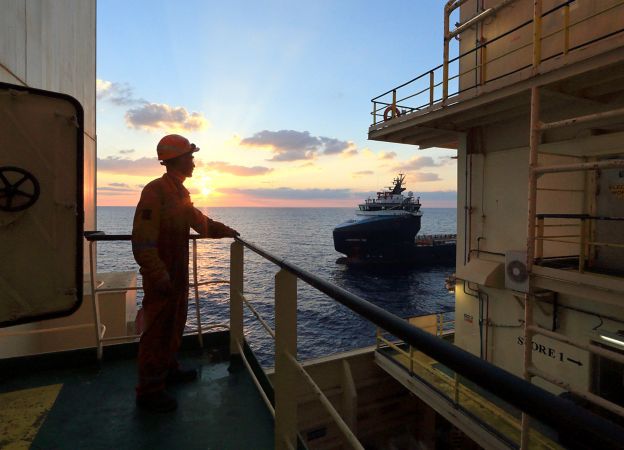50,1
miliardi di m³
produzione annuale di gas naturale nel 2024

Oppure , la nostra nuova soluzione di intelligenza artificiale.
Oppure , la nostra nuova soluzione di intelligenza artificiale.
Utilizziamo le migliori tecnologie esplorative per ricostruire la struttura delle rocce sotterranee.
Investiamo costantemente per essere all’avanguardia nell’acquisizione, gestione e interpretazione dei dati di sottosuolo. Solo migliorando le nostre competenze nelle discipline della geologia e della geofisica, nella loro integrazione e nello sviluppo dei modelli che se ne possono derivare, avremo la possibilità di rendere più approfondita e allo stesso tempo più rapida la comprensione del sottosuolo, ottimizzando i rischi operativi ed economici insiti nelle nostre attività e riducendo l’impatto sull’ambiente.
Il continuo aggiornamento delle conoscenze teoriche nell’ambito delle geoscienze, accompagnato da un sempre maggiore utilizzo delle tecnologie digitali, permetterà di rendere più efficienti e sicuri i flussi di lavoro applicati allo studio del sottosuolo, sia per fini diretti all’esplorazione tradizionale, come la ricerca di nuovi campi a gas, sia per attività a supporto della transizione energetica, come la definizione e la gestione nel tempo dei siti destinati allo stoccaggio della CO2, o l’esplorazione finalizzata alla ricerca di siti geotermici, di giacimenti di idrogeno e minerali critici.
In questo sono fondamentali le geoscienze sperimentali, un insieme di discipline in ambito geologico finalizzate a ricostruire la struttura delle rocce sotterranee in cui potrebbero essere presenti idrocarburi. Il loro prezioso contributo si integra costantemente con quello delle geoscienze digitali, supportate dai nostri supercomputer. Queste discipline, inoltre, vengono applicate anche nella cattura e stoccaggio della CO2.
Grazie alle competenze e alle tecnologie dei nostri Centri di Ricerca siamo in grado di individuare nuovi giacimenti di gas naturale in modo sempre più preciso ed efficiente.
Una leva tecnologica per accelerare la trasformazione di Eni e sostenere lo sviluppo di nuovi business ad alto potenziale.

La potenza di calcolo dei supercomputer, unita alle competenze di geologi e ingegneri, è il segreto dei nostri successi nell’esplorazione geofisica.

I nostri laboratori si sono dotati di strumentazioni sempre più avanzate per l’analisi dei campioni rocciosi dal sottosuolo.

Utilizzando HPC6, i nostri ricercatori possono conoscere il sottosuolo in modo sempre più preciso e sicuro.
Lo studio del sottosuolo si fonda su conoscenze teoriche di base che si applicano sia agli obiettivi tradizionali che a quelli legati alla transizione energetica. Risalire all’età delle formazioni rocciose sotterranee, studiare la loro composizione, porosità e permeabilità, così come ricostruire la geometria, l’estensione e il volume dei corpi sedimentari e le condizioni paleo ambientali in cui si sono formati, sono operazioni fondamentali per comprendere la natura e le caratteristiche dei reservoir da cui estrarre gas naturale o da utilizzare a fini di stoccaggio di CO2.
Oltre ad avvalersi di competenze teoriche aggiornate e di moderni flussi di lavoro integrati, creati appositamente, i nostri tecnici hanno accesso all’utilizzo di tecnologie e di sofisticati strumenti di analisi che consentono di studiare i dati estratti dal sottosuolo in modo dettagliato e di ottimizzare il raggiungimento dei risultati.
Non da ultimo, lo studio della geologia di superficie, attraverso campagne di rilevamento di rocce affioranti o grazie all’uso di acquisizioni digitali della superficie terrestre, ci permettono di ottenere dati fondamentali a supporto delle attività di modelling geologico, nonché di monitoraggio dei siti in cui operiamo (studi ambientali). Dotarsi di tecnologie proprietarie avanzate che permettano di acquisire ed elaborare grandi quantità di dati ad elevata qualità, è quindi fondamentale per aumentare la nostra capacità di prevedere la variabilità delle rocce del sottosuolo.
I progressi della tecnologia e delle tecnologie digitali, in particolare, hanno permesso di incrementare notevolmente le performance delle attività sperimentali, come ad esempio le analisi di laboratorio. Le moderne metodologie di machine learning e di intelligenza artificiale offrono inoltre la possibilità di ottimizzare la gestione dei database proprietari e della loro integrazione con i dati disponibili nei database pubblici o riconducibili alla letteratura specializzata. L’aumento della robustezza dei modelli geologici quantitativi tridimensionali passa infatti anche dalla necessità di calibrarli su un elevato numero di dati da analizzare e integrare in tempi sempre più brevi, a fronte di una disponibilità di informazioni in costante aumento.
Gli ultimi risultati e gli obiettivi di crescita nel gas naturale.
produzione annuale di gas naturale nel 2024
componente gas sul totale della produzione O&G entro il 2030
componente gas sul totale della produzione O&G entro il 2050
Un viaggio alla scoperta della geologia.
Nella playlist "I cacciatori di rocce" il geologo Emiliano Mutti, premiato da Eni Award nel 2016, ci guida nello studio del patrimonio geologico dei Pirenei e degli Appennini, un percorso dalla grande valenza accademica, industriale ed estetica.
Guarda la playlistUn viaggio alla scoperta della geologia.
25 ottobre 2016
Il nostro supercomputer ci permette di ampliare l’esplorazione geofisica.
La profonda conoscenza del sottosuolo che, grazie alle geoscienze, abbiamo maturato con le nostre attività nell’Oil & Gas, si rivela preziosa nell’ambito della cattura, stoccaggio e utilizzo della CO2 (CCUS). Studiare e comprendere le caratteristiche delle rocce sotterranee e il comportamento dei fluidi che si muovono al loro interno, in particolare attraverso le geoscienze sperimentali, ci permette di valutare con precisione la capacità di immagazzinare l’anidride carbonica da parte dei giacimenti a gas ormai esauriti. In questo modo, possiamo individuare quelli più adatti ad accogliere impianti di cattura e stoccaggio della CO2 (CCS) e, successivamente, siamo in grado di gestirne l'operatività con sicurezza ed efficienza.
I nostri progetti per la cattura, lo stoccaggio e l’utilizzo della CO₂ , un insieme di tecnologie indispensabili per ridurre le emissioni.
I luoghi e le persone di Eni raccontano le tecnologie chiave della transizione - A Roma Gabriella Greison incontra Niccolò Percudani che spiega perché il gas è un elemento fondamentale per la sicurezza nell'approvvigionamento energetico.
15 maggio 2024

Se desideri cambiare argomento, svuota la chat ed effettua una nuova richiesta per ottenere risultati più pertinenti.
Questa azione comporterà l'eliminazione di tutte le domande fatte durante la fase di navigazione.
Con questa azione cancellerai ogni ricerca effettuata durante questa sessione di navigazione.
Qui puoi trovare la lista di tutte le tue richieste.
Le risposte sono generate dall'intelligenza artificiale, pertanto potrebbero contenere imprecisioni. Leggi i termini e condizioni di utilizzo

EnergIA è uno strumento innovativo basato sulle capacità dell’intelligenza artificiale, che può aiutarti a navigare tra i contenuti di eni.com, trovando subito la risposta alle tue domande. EnergIA può effettuare una ricerca su un tema specifico, fornendo i dati più aggiornati disponibili, oppure può invitarti ad approfondire un argomento di tuo interesse. Inizia subito!
EnergIA è uno strumento innovativo basato sulle capacità dell’intelligenza artificiale, che può aiutarti a navigare tra i contenuti di eni.com, trovando subito la risposta alle tue domande. Inizia ora!
EnergIA è un sistema basato sull’Intelligenza Artificiale Generativa.
Grazie a questa tecnologia riusciamo a rispondere alle tue richieste interrogando i contenuti e i documenti più rilevanti presenti su eni.com. (N.B. Vengono presi in considerazione i documenti finanziari degli ultimi 12 mesi e i comunicati stampa degli ultimi 2 anni.)
Attraverso EnergIA puoi approfondire le tematiche di tuo interesse e avere una finestra in tempo reale sul mondo Eni.
Se desideri, invece, cercare uno specifico documento, comunicato stampa o news, utilizza il motore di ricerca tradizionale tramite icona della lente.
Come tutti i sistemi che sfruttano l’Intelligenza Artificiale Generativa, EnergIA potrebbe generare risposte inesatte o non aggiornate. Ti invitiamo sempre a consultare le fonti che il sistema indica come origine dell’informazione generata.
In alcuni casi, in assenza di una perfetta corrispondenza con la richiesta, il sistema cerca comunque di fornire una risposta.
Qualora dovessi riscontrare delle inesattezze nella risposta fornita, ti preghiamo di segnalarcelo tramite il feedback disponibile a fondo pagina: ci sarà molto utile per migliorare.
Dal momento che quanto elaborato dal sistema non rappresenta la posizione ufficiale di Eni, invitiamo gli stakeholder interessati a conoscere le posizioni della Società a rivolgersi ai propri contatti di riferimento: Ufficio Stampa per i giornalisti, Investor Relations per analisti e investitori, Segreteria Societaria per gli azionisti etc..
EnergIA riesce a comprendere domande poste in quasi tutte le lingue, ma preferiamo fornirti una risposta in inglese o in italiano, le due lingue disponibili su eni.com.
Se poni una domanda in lingua italiana, saranno consultati i contenuti presenti sul sito in lingua italiana. Se la poni in inglese o in qualsiasi altra lingua, saranno consultati i contenuti in lingua inglese. (N.B. La lingua che Eni utilizza per i documenti/contenuti di carattere finanziario è prevalentemente l’inglese.)
Nel caso in cui vengano formulate domande che violino i criteri di sicurezza impostati, il sistema non procederà con l'elaborazione della risposta. Infine, ti chiediamo di non inviare dati personali.
Utilizzando questo servizio, l’utente dichiara di aver letto e accettato i termini e condizioni di utilizzo.
Ricerca
EnergIA è un sistema basato sull’Intelligenza Artificiale Generativa.
Grazie a questa tecnologia riusciamo a rispondere alle tue richieste interrogando i contenuti e i documenti più rilevanti presenti su eni.com. (N.B. Vengono presi in considerazione i documenti finanziari degli ultimi 12 mesi e i comunicati stampa degli ultimi 2 anni.)
Attraverso EnergIA puoi approfondire le tematiche di tuo interesse e avere una finestra in tempo reale sul mondo Eni.
Se desideri, invece, cercare uno specifico documento, comunicato stampa o news, utilizza il motore di ricerca tradizionale tramite icona della lente.
Come tutti i sistemi che sfruttano l’Intelligenza Artificiale Generativa, EnergIA potrebbe generare risposte inesatte o non aggiornate. Ti invitiamo sempre a consultare le fonti che il sistema indica come origine dell’informazione generata.
In alcuni casi, in assenza di una perfetta corrispondenza con la richiesta, il sistema cerca comunque di fornire una risposta.
Qualora dovessi riscontrare delle inesattezze nella risposta fornita, ti preghiamo di segnalarcelo tramite il feedback disponibile a fondo pagina: ci sarà molto utile per migliorare.
Dal momento che quanto elaborato dal sistema non rappresenta la posizione ufficiale di Eni, invitiamo gli stakeholder interessati a conoscere le posizioni della Società a rivolgersi ai propri contatti di riferimento: Ufficio Stampa per i giornalisti, Investor Relations per analisti e investitori, Segreteria Societaria per gli azionisti etc..
EnergIA riesce a comprendere domande poste in quasi tutte le lingue, ma preferiamo fornirti una risposta in inglese o in italiano, le due lingue disponibili su eni.com.
Se poni una domanda in lingua italiana, saranno consultati i contenuti presenti sul sito in lingua italiana. Se la poni in inglese o in qualsiasi altra lingua, saranno consultati i contenuti in lingua inglese. (N.B. La lingua che Eni utilizza per i documenti/contenuti di carattere finanziario è prevalentemente l’inglese.)
Nel caso in cui vengano formulate domande che violino i criteri di sicurezza impostati, il sistema non procederà con l'elaborazione della risposta. Infine, ti chiediamo di non inviare dati personali.
Utilizzando questo servizio, l’utente dichiara di aver letto e accettato i termini e condizioni di utilizzo.
Una nuova finestra sul mondo Eni, a tua disposizione. EnergIA è uno strumento innovativo basato sulle capacità dell’intelligenza artificiale, che può aiutarti a navigare tra i contenuti di eni.com, trovando subito la risposta alle tue domande.


